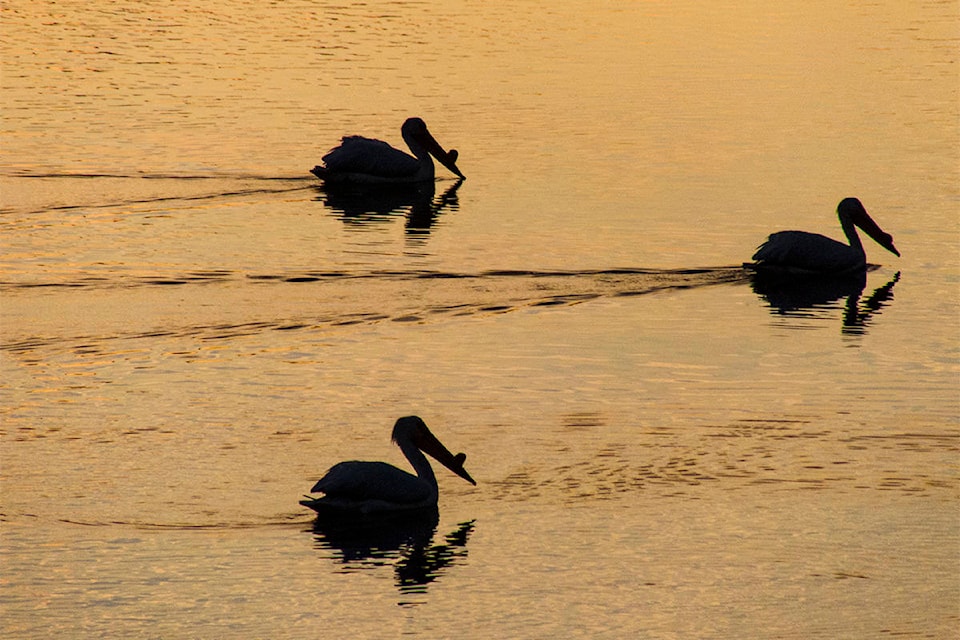Carmen Traub
Observer Contributor
During the American white pelican’s migration, it stops here to breed on Quesnel’s beautiful lakes. This bird is not on the endangered species list on a global scale, but it is here in British Columbia, due to its reduction in numbers over the years.
Quesnel is one of a handful of places where the American white pelican stops to mate as flocks migrate to spring nesting grounds in Stum Lake, B.C., which is about 103 km from Quesnel. Stum Lake is the only nesting colony for American white pelicans in B.C. It is a government-run provincial park, and from March 1 to August 31, the park is closed to the public for the nesting season in order to protect the species. Aircraft landing is prohibited, and restriction on flight elevation is enforced during this time. All watersports on the lake are also restricted, since the birds are highly affected by human interference and will abandon their nests if disturbed.
It’s never a good sign when we lose a species in a region, as it effects the entire ecosystem. We learned this from pioneer Eric Collier, who repopulated the Meldrum Creek watershed with beavers, west of the Fraser River near Williams Lake in the 1930s. The massive fur trade, gold panning, and ranching had driven the beaver to extinction, which in turn depleted the watershed.
Without the beaver dams jamming the creeks, the ponds and marshes became dry. This caused a chain reaction: the fish stopped filling the ponds, which stopped the water birds from visiting the area. Other fish-eating animals starved, and predators of birds in the area began to starve for lack of food. Gone were the mink, otters, and muskrats too. Without insects, which thrive on and near still water, other insect-eating creatures died. Farming was greatly affected as well. Without enough readily available water for farming fields, the homesteaders went further upstream to find irrigation water, further depleting the creek until it became a small trickle. Forest fires would be left to rage, whereas ponds and marshes would have kept them at bay. Surrounding trees and grasses that were once thriving by the ponds, marshes and lakes became stubble and the deer and moose lost their food and watering holes.
The extent of havoc that the loss of one species can cause throughout an entire region is devastating. Collier and his wife brought back the beaver and life returned to that region.
Today, thankfully, the Province of British Columbia Ministry of Environment and Climate Change Strategy is concerned about protecting the ecosystem and its species and has taken steps to protect the endangered American white pelican, which has become an important part of our Canadian waterways. The Ontario government is also on board, and has executed a recovery strategy that protects the breeding and nesting grounds of the bird in that province. They have seen some recovery and have moved the bird from endangered status to threatened status. Ontario and British Columbia are the birds’ main migration stops in Canada.
Aside from the environmental impact of losing this species, it would be such a heartbreak to lose this fascinating bird. It may carry the regional destination name “American”, but we all share its glory and concern for its survival, especially when so many are conceived and born right here in B.C. Watching this majestic bird soar in the sky with its nine-foot wingspan is breathtaking! On land, it stands four-foot tall, but you would never know this bird’s grand expanse if you saw it floating on the water in its very compact sleeping position.
During mating season, this bird miraculously transforms its shape and color: their eyes turn from dark brown to almost white in colour, their skin and beak changes to a very bright orange, they grow a tuft of feathers on the top of their heads, and a large flat vertical rounded horn develops on their beak. This horn falls off after breeding, and their eyes and skin go back to their original colour.
As I captured images of the breathtaking American white pelican from a respectful distance near a local Quesnel lake, for the first time since encountering pelicans, I was not distressed about seeing injured birds; from where I stood, they looked extremely healthy. Previously, I had volunteered as a seabird rescuer in Australia, and the sheer numbers of pelicans injured and entangled by fishing tackle was devastating, as they suffered from torn pouches; infected body parts with embedded fish hooks; and wings entangled in fishing line.
But I didn’t witness that here in Quesnel. I really believe it is largely due to Canadian fishermen being responsible with their environmental footprint and taking care of their hooks and lines. I also believe that Quesnel’s healthy bird life is due to responsible garbage pick-up enforced by the government, which protects the waterways. On a micro level, people in general have been more concerned about garbage and the impact on the environment.
Learn more about the American white pelican here: http://endangeredspecies2050.com/american-white-pelican-endangered-in-canada/.
Carmen Traub is one of the founders of www.endangeredspecies2050.com.
